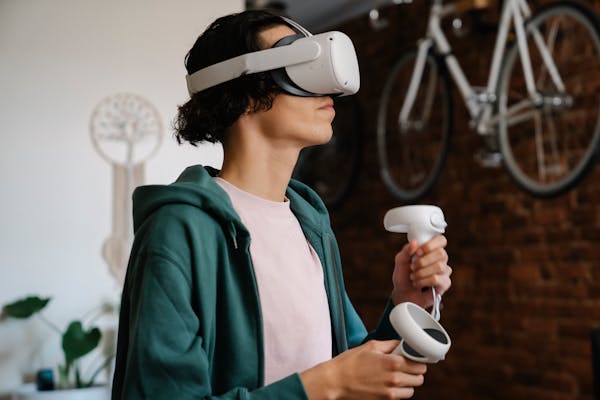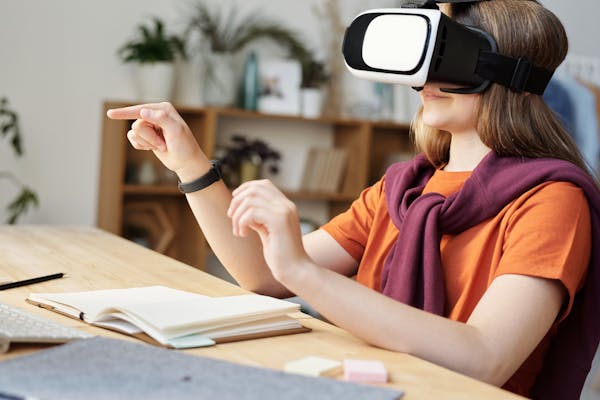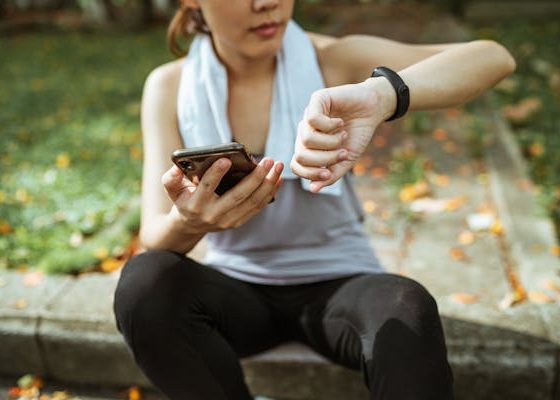
Augmented Reality (AR) is a technology that superimposes digital information and virtual objects onto the real world, providing an enriched and interactive user experience. The applications of augmented reality span across various industries, revolutionizing the way we interact with our environment, perform tasks, and consume information. This article explores the diverse applications of augmented reality, highlighting its impact and potential in transforming multiple sectors.
The Different Applications of Augmented Reality
1. Healthcare
a. Medical Training and Education
One of the most significant applications of augmented reality in healthcare is in medical training and education. AR provides medical students and professionals with immersive and interactive learning experiences. For instance, AR-enabled applications can project 3D models of human anatomy, allowing students to explore and understand complex structures in a detailed and hands-on manner. Surgeons can also use AR to simulate surgeries, practicing procedures in a risk-free virtual environment.
b. Surgical Assistance
AR is increasingly being used in the operating room to assist surgeons during complex procedures. By overlaying critical information, such as patient vitals and anatomical guides, directly onto the surgical field, AR enhances precision and reduces the risk of errors. Applications of augmented reality in surgical assistance include guiding minimally invasive surgeries and improving the accuracy of tumor resections.
c. Patient Care
AR can enhance patient care by providing real-time information and interactive experiences. For example, AR applications can help patients understand their medical conditions and treatment plans through visualizations. Additionally, AR can assist in physical therapy by offering interactive exercises and real-time feedback, making rehabilitation more engaging and effective.
2. Education

a. Interactive Learning
In the realm of education, the applications of augmented reality are transforming traditional learning methods. AR enables the creation of interactive and immersive educational content that makes learning more engaging and effective. For instance, AR applications can bring historical events to life, allowing students to explore ancient civilizations through 3D reconstructions and interactive timelines.
b. Enhanced Textbooks
AR-enhanced textbooks are becoming increasingly popular in classrooms. These textbooks use AR markers to trigger digital content, such as videos, animations, and 3D models, which complement the printed material. This interactive approach helps students grasp complex concepts and enhances their understanding of subjects like science, mathematics, and history.
c. Virtual Field Trips
Virtual field trips powered by AR allow students to explore distant locations and experience different cultures without leaving the classroom. By overlaying digital content onto real-world environments, AR applications can simulate visits to historical sites, natural landmarks, and even outer space. This immersive experience fosters curiosity and enhances students’ learning experiences.
3. Retail and E-commerce
a. Virtual Try-Ons
One of the most popular applications of augmented reality in retail is virtual try-ons. AR allows customers to try on clothing, accessories, and even makeup virtually. By using their smartphone or AR-enabled mirrors, shoppers can see how products will look on them without physically trying them on. This technology enhances the shopping experience, reduces the need for physical samples, and helps customers make more informed purchasing decisions.
b. Interactive Product Visualization
AR enables retailers to provide interactive product visualizations, allowing customers to see products in detail and from different angles. For example, furniture retailers can offer AR applications that let customers visualize how furniture pieces will look in their homes. This interactive experience helps customers make better purchasing decisions and reduces the likelihood of returns.
c. In-Store Navigation and Information
AR applications can enhance the in-store shopping experience by providing real-time navigation and information. Shoppers can use AR-enabled apps to find specific products, receive personalized recommendations, and access detailed product information. This technology improves convenience and efficiency, making the shopping experience more enjoyable and satisfying.
4. Real Estate
a. Virtual Property Tours
In the real estate industry, the applications of augmented reality are transforming the way properties are marketed and sold. AR enables virtual property tours, allowing potential buyers to explore properties remotely. By using AR applications, buyers can walk through properties, visualize different layouts, and even see how furniture and decor will look in the space. This immersive experience saves time and enhances the decision-making process.
b. Property Visualization and Customization
AR applications allow real estate developers and agents to showcase properties before they are built. By overlaying digital models onto construction sites, potential buyers can visualize the final product and make informed decisions. Additionally, AR can enable customization options, allowing buyers to see how different finishes, colors, and layouts will look in the property.
c. Interactive Floor Plans
AR can bring traditional floor plans to life by providing interactive and immersive experiences. Potential buyers can use AR applications to visualize floor plans in 3D, explore different room configurations, and understand the spatial relationships between different areas. This interactive approach helps buyers better understand the property and make more confident decisions.
5. Gaming and Entertainment

a. Immersive Gaming Experiences
The gaming industry has been one of the early adopters of augmented reality, with AR games becoming increasingly popular. AR games blend the virtual and real worlds, providing immersive and interactive experiences. Players can interact with virtual objects and characters that are overlaid onto their real-world environment. This technology enhances gameplay and offers unique and engaging experiences.
b. Location-Based Gaming
Location-based gaming is another exciting application of augmented reality. These games use the player’s real-world location as part of the gameplay. For example, Pokémon GO, one of the most popular AR games, encourages players to explore their surroundings to find and capture virtual creatures. This blend of physical activity and gaming creates a unique and engaging experience.
c. Augmented Reality Theaters and Theme Parks
AR is also being used to enhance experiences in theaters and theme parks. AR-enabled theaters can provide interactive and immersive experiences, allowing audiences to see virtual characters and effects that blend seamlessly with the live performance. Theme parks can use AR to create interactive attractions, where visitors can interact with virtual elements and characters, enhancing the overall experience.
6. Manufacturing and Industry
a. Maintenance and Repair
In the manufacturing and industrial sectors, the applications of augmented reality are improving maintenance and repair processes. AR applications can provide technicians with real-time information and step-by-step instructions, overlaid directly onto the equipment. This technology reduces downtime, improves accuracy, and enhances the efficiency of maintenance and repair tasks.
b. Training and Skill Development
AR is being used to train and upskill workers in various industries. AR applications can simulate real-world scenarios, allowing workers to practice tasks and procedures in a safe and controlled environment. For example, AR can be used to train workers in assembly processes, quality control, and safety procedures. This interactive training approach enhances learning outcomes and improves worker performance.
c. Design and Prototyping
AR is transforming the design and prototyping processes in manufacturing. Designers can use AR applications to visualize and interact with digital models of products, allowing them to make adjustments and improvements before physical prototypes are created. This technology reduces the time and cost associated with the design and prototyping stages, accelerating the development process.
7. Tourism and Travel
a. Augmented Reality Tours
The applications of augmented reality in tourism and travel are enhancing the way people explore and experience new destinations. AR tours provide visitors with interactive and informative experiences, overlaying digital content onto real-world locations. For example, AR applications can provide historical information, facts, and stories about landmarks and attractions, enriching the visitor experience.
b. Navigation and Wayfinding
AR can improve navigation and wayfinding for travelers. AR-enabled navigation apps can overlay directions, points of interest, and real-time information onto the real world, making it easier for travelers to find their way and explore new places. This technology enhances convenience and reduces the stress associated with navigating unfamiliar environments.
c. Interactive Travel Guides
AR applications can serve as interactive travel guides, providing travelers with personalized recommendations and information. By using AR, travelers can discover hidden gems, find the best restaurants and attractions, and access reviews and ratings from other travelers. This interactive approach enhances the travel experience and helps travelers make the most of their trips.
8. Architecture and Construction
a. Visualization and Design
In the architecture and construction industries, the applications of augmented reality are transforming the way projects are visualized and designed. AR allows architects and designers to overlay digital models onto real-world sites, providing a realistic and immersive view of the final product. This technology enhances communication with clients and stakeholders, making it easier to convey design concepts and make informed decisions.
b. Construction Planning and Management
AR is improving construction planning and management by providing real-time information and visualizations. AR applications can overlay project plans, schedules, and progress updates onto the construction site, helping project managers monitor and manage the project more effectively. This technology enhances collaboration, improves accuracy, and reduces the risk of errors and delays.
c. Safety and Training
AR is enhancing safety and training in the construction industry. AR applications can simulate hazardous scenarios, allowing workers to practice safety procedures and protocols in a controlled environment. Additionally, AR can provide real-time safety information and alerts, helping workers stay aware of potential hazards and improving overall safety on the construction site.
9. Marketing and Advertising
a. Interactive Advertising
The applications of augmented reality in marketing and advertising are creating more engaging and interactive experiences for consumers. AR advertisements can overlay digital content, such as videos, animations, and interactive elements, onto physical ads, making them more captivating and memorable. This technology enhances brand engagement and increases the effectiveness of advertising campaigns.
b. Product Demonstrations
AR is being used to create interactive product demonstrations, allowing consumers to see and interact with products in a virtual environment. For example, automotive companies can use AR to showcase new car models, allowing consumers to explore interior and exterior features in detail. This interactive approach enhances the consumer experience and helps drive sales.
c. Event and Experiential Marketing
AR is transforming event and experiential marketing by creating immersive and interactive experiences. Brands can use AR to create engaging activations at events, such as virtual photo booths, interactive games, and augmented reality scavenger hunts. This technology enhances the event experience, creates memorable interactions, and strengthens brand loyalty.
10. Military and Defense
a. Training and Simulation
In the military and defense sectors, the applications of augmented reality are enhancing training and simulation programs. AR can create realistic training scenarios, allowing soldiers to practice tactics, procedures, and decision-making in a safe and controlled environment. This technology improves the effectiveness of training programs and enhances soldier readiness.
b. Tactical Augmented Reality
Tactical augmented reality (TAR) is being used to provide soldiers with real-time information and situational awareness on the battlefield. TAR systems can overlay critical information, such as enemy positions, navigation routes, and mission objectives, onto the soldier’s field of view. This technology enhances decision-making, improves communication, and increases operational effectiveness.
c. Maintenance and Repair
AR is also being used to improve maintenance and repair processes in the military. AR applications can provide technicians with real-time information, step-by-step instructions, and visualizations, helping them perform maintenance and repairs more accurately and efficiently. This technology reduces downtime and enhances the readiness of military equipment.
Conclusion
The applications of augmented reality are transforming industries and experiences across the globe. From healthcare and education to retail, real estate, gaming, manufacturing, tourism, architecture, marketing, and defense, AR is revolutionizing the way we interact with the world. As AR technology continues to advance, its potential to create immersive, interactive, and engaging experiences will only grow, driving innovation and transforming the way we live and work. The future of augmented reality is bright, and its applications are limitless.
